 Getting to Ravello is a bit tricky and is part of the adventure. It sits 1,000 feet above the sea and the 30 minutes drive up from Amalfi made me bite off every last fingernail (and possibly a few of my toenails as well)! We had rented a little convertible Fiat in Sorrento and zoomed our way South past the towns of Positano and Amalfi with the soft top-down, not a care in the world. Now, this is where it gets real, my friends. I actually closed my eyes while Luke drove up the narrow (and I'm talking down to almost one lane) road that had the most amount of switchbacks I have ever experienced. Although coming back down was worse; it was kind of like riding a tricycle down a spiral staircase.
Getting to Ravello is a bit tricky and is part of the adventure. It sits 1,000 feet above the sea and the 30 minutes drive up from Amalfi made me bite off every last fingernail (and possibly a few of my toenails as well)! We had rented a little convertible Fiat in Sorrento and zoomed our way South past the towns of Positano and Amalfi with the soft top-down, not a care in the world. Now, this is where it gets real, my friends. I actually closed my eyes while Luke drove up the narrow (and I'm talking down to almost one lane) road that had the most amount of switchbacks I have ever experienced. Although coming back down was worse; it was kind of like riding a tricycle down a spiral staircase.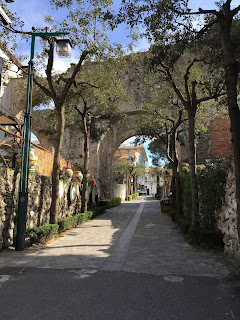
Finding parking was easy at this time of year. We just followed the main road into town and there were signs for a public parking lot. This lot was the only flat place in town to park, and it was quite reasonable.
Ravello has no huge tourist attractions, yet the whole of the town is a tourist attraction. Ravello is known for its great summer classical music festivals called The Ravello Festival. TIP #1: THE WEBSITE Ravello.com HAS ALL THE INFORMATION YOU NEED TO PLAN YOUR TRIP. The website above has information on concert events in Ravello, accommodation, food and wine.

There are many ruins in Ravello, old city walls and aqueducts but they are not Roman. In fact, because of Ravellos location on such a steep slope high above the sea, life was very hard for the early inhabitants. The town was built in the 5th century by people hiding out from pirate attacks and barbarian invasions. The walls around the city date from around 1000 when Ravello broke off from its powerful neighbour Amalfi. Ravello got its own bishop and gained wealth and power through its wool industry and became a thriving town of 25,000 people; ten times more inhabitants than today. Unfortunately, becoming powerful means that you are subject to attack and Ravello was sacked in 1137 by Pisa and never fully recovered. Many of the rich inhabitants ended up moving to nearby Amalfi and Naples, and Ravello slipped into the mists of time until it was rediscovered in the Romantic age by nobles, artists and musicians.

Ravello's main square is Piazza del Duomo surrounded by cypress trees and huge umbrella pines. Like the Amalfi Cathedral, Ravello's Duomo has a great Arabic influence in its architecture. To the right of the Duomo is an old stone watchtower that is the entrance to the Villa Rufolo. This is a 13th-century palace built by the noble Rufolo family, later restored in the 1850s by a British noble who purchased the villa.
We decided to go on a bit of a treasure hunt to see a different villa; Villa Cimbrone. It's a bit of a trek through Ravello to get to Villa Cimbrone, which is on the opposite end of Ravello but you get to see the less touristic part of the town and enjoy the quiet beauty here. To get to the villa you must exit the Piazza Del Duomo, walk through a huge stone tunnel and follow signs (that keep pointing up) luring you through tiny lanes and up staircases where you catch glimpses of the terraced lemon groves and vineyards far below.
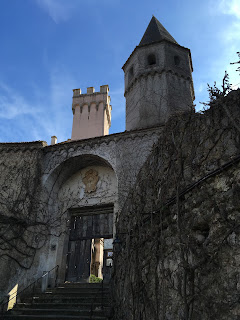
Finally, we meet the magnificent fairy tale gates of Villa Cimbrone. The villa was built in the 11th century on the ruins of a convent of Santa Chiarra. The villa was passed around to many noble Italian families through the centuries, unfortunately leaving it in a ruined state. In 1904 an English Lord fell in love with the property and decided to purchase it and re-build the villa and gardens into a romantic English castle high above the Mediterranean. It costs €7 to enter the villa to tour the gardens. Villa Cimbrone is now a 5-star hotel so you can not tour the villa buildings unless you are a guest. For hotel prices and information got to www.hotelvillacimbrone.com
When you purchase your tickets you get a very good map of the gardens with great information on all of the sights. Keep in mind that all you see here in the villa is only about 100 years old!
 |
| The Cloister Of Villa Cimbrone |
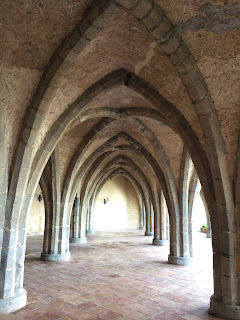 |
| Crypt Of Villa Cimbrone |
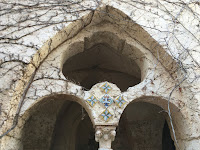 |
| "Ancient" look alike |
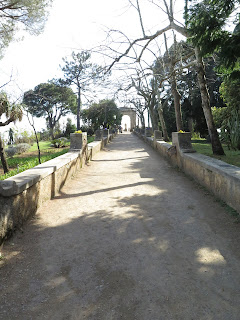 |
| Avenue of Immensity |
To the right of the ticket booth are the cloister and the crypt. These were built in 1911 by Lord Grimthorpe's design. The crypt is very popular as a wedding reception dinner venue because of its fantastic views, acoustics and atmosphere. In fact, we were glad we were not here during the wedding season because the place is crawling with wedding parties or brides to be scouting out wedding locations; we practically had the place to ourselves. Unfortunately, once again because it was off-season the Terrace Cafe was not open and only the magnolia trees were starting to bloom. Follow the long main pathway called "The Avenue of Immensity" toward the pavilion at the end. In the summer this pathway has beautiful wisteria vines whose blossoms cascade over arches along the lane.
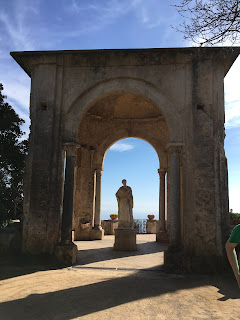 |
| Doorway of the Sun |
Then you come upon the most astonishing sight of the gardens of Villa Cimbrone; they may look a little familiar to some of you. Here is "The Doorway of the Sun" a pavilion with a statue of the Goddess Ceres in the centre. Ceres is the Roman equivalent of the Greek Goddess Demeter, Goddess of harvest, agriculture and fertility. This is also the portal to the famous "Terrace of Infinity" a natural belvedere that has a 360-degree view of the coast. This balcony was recently featured in the Wonder Woman movie as Diana's (aka Wonder Woman) home; it truly is fit for a Goddess.
 |
| Terrace of Infinity |
We probably took a hundred photos of the view, the terrace, the 18th-century marble statues; it was all so jaw-droppingly gorgeous. There is something bewitching about this terrace and time seems to stand still here. The blue of the sea and the blue of the sky seem to blend together to become infinity. TIP #2: THERE IS A CAFE HERE IN THE TOURIST SEASON. This would be a great place to grab a coffee or gelato and sit on the marble benches of the terrace and enjoy your view of infinity. Unfortunately, the cafe was closed at this time of year but to be in this place alone as a family was incredible.
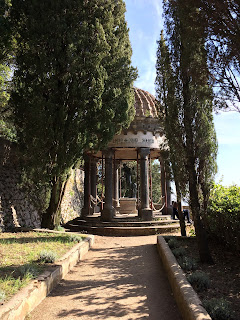 |
| Temple of Bacchus |
The pathway gets a little more rugged here and leads to more little garden vignettes with statues, pergolas and stunning views such as Mercury's Seat, The Temple of Bacchus (where Lord Grimthorpe is buried) and Eve's Grotto. There is also a formal English rose garden and an outdoor structure called The Tea Room which was an intimate outdoor entertaining area for the Lord of the house. Now it is a favourite place for wedding vows and other special occasions.
 |
| To The "Tea Room" |
We left Villa Cimbrone charmed by the romanticism of this special hotel and inspired by the idea that money CAN buy fairy tales. Giggling as we walked back out the huge wooden entry gates; Luke makes his favourite (bad Dad) joke; in a statement of mock disgust he declares: "Ugh, what a dump that place was!"
It was time to head back to our rental car and make our way back up the Amalfi Coast to Marina Grande in Sorrento for our last night in Italy. In a few short hours, it will be time for us to go back to our "vita contadina" or in English, peasant life. But we will dream of Villa Cimbrone and beatitudine da favola.


No comments:
Post a Comment